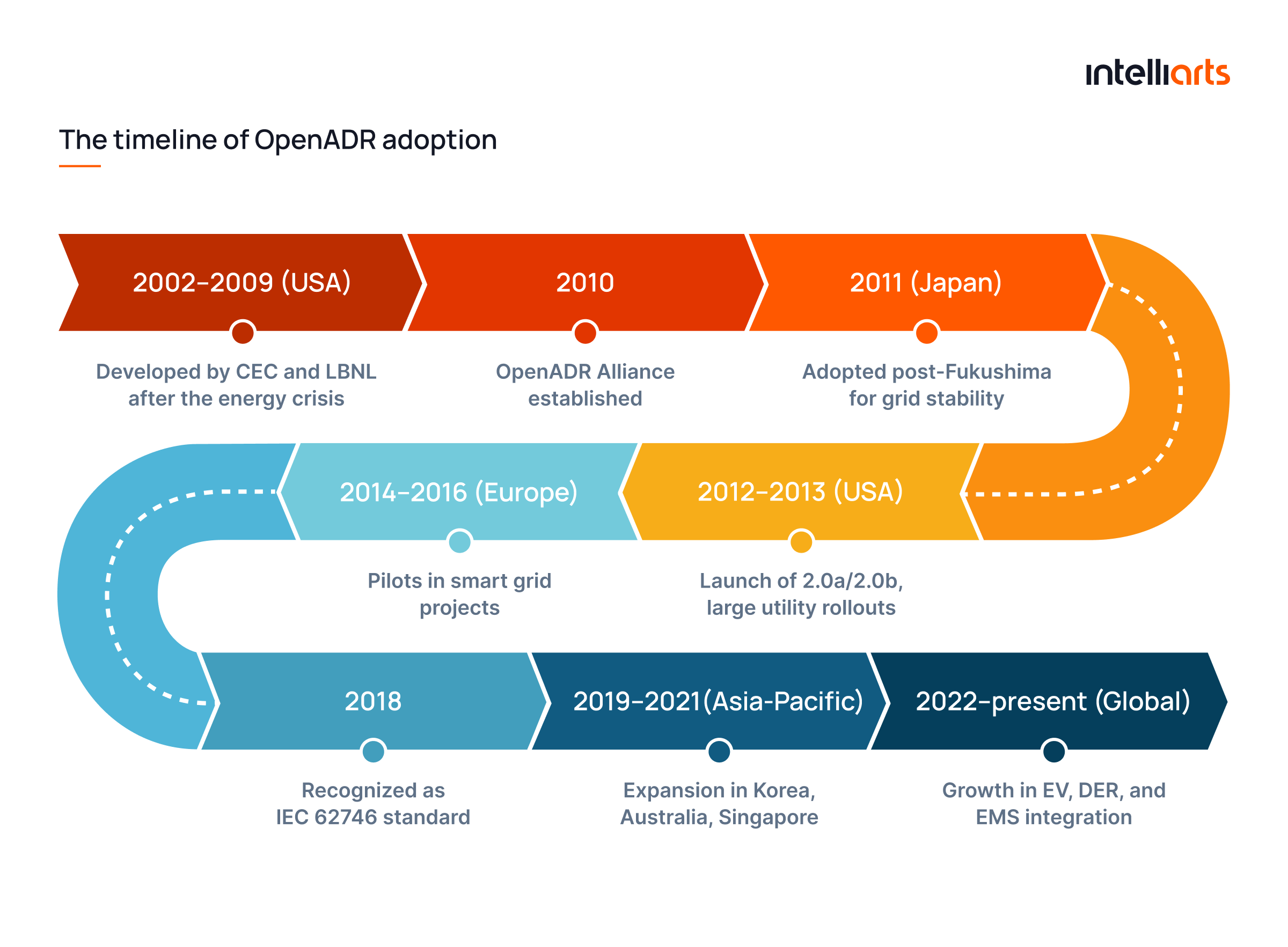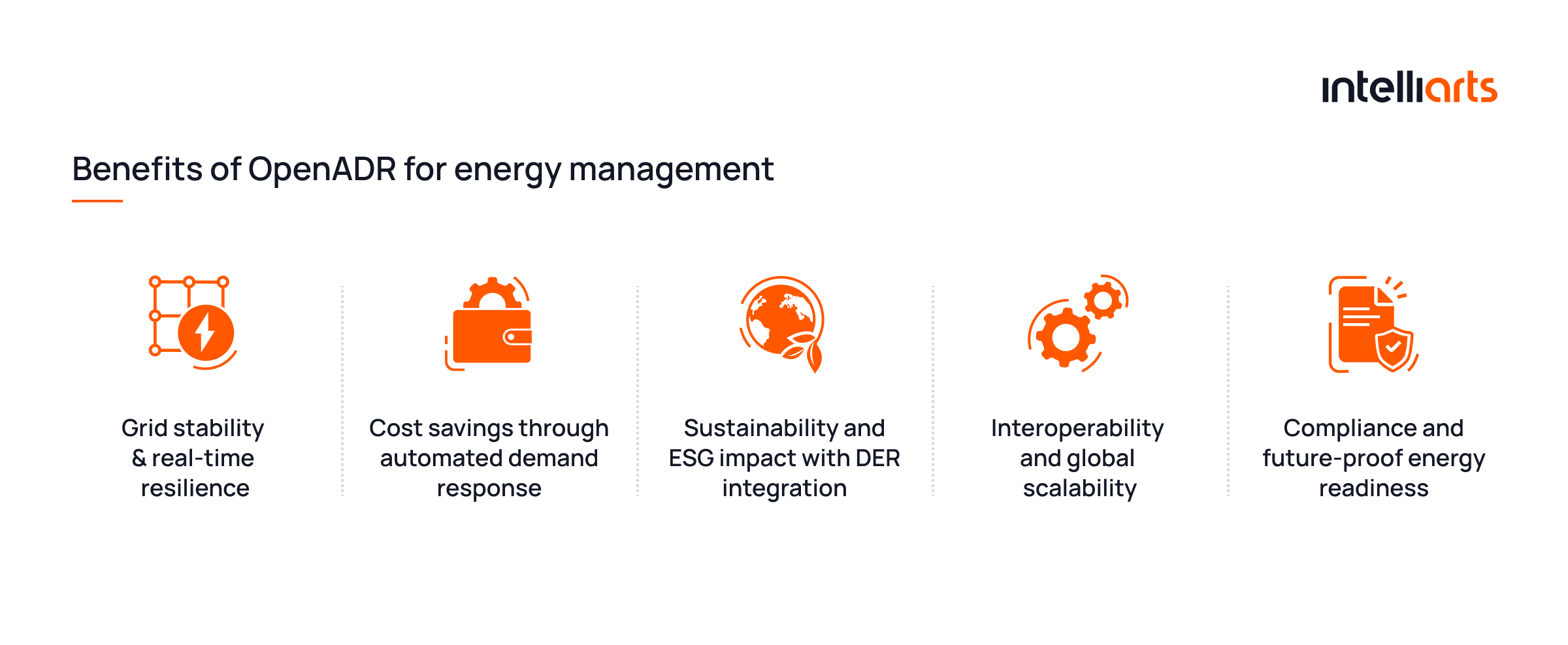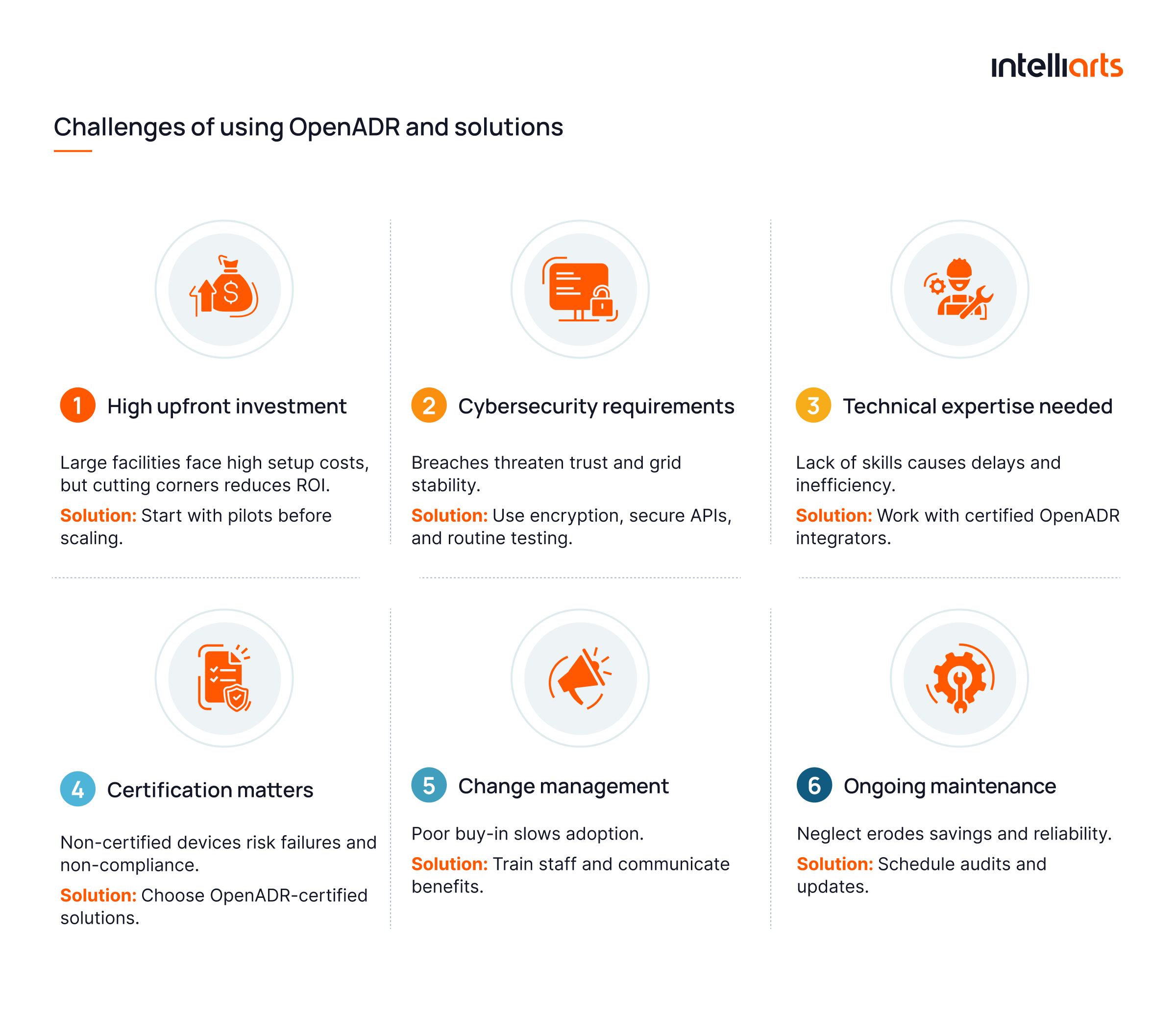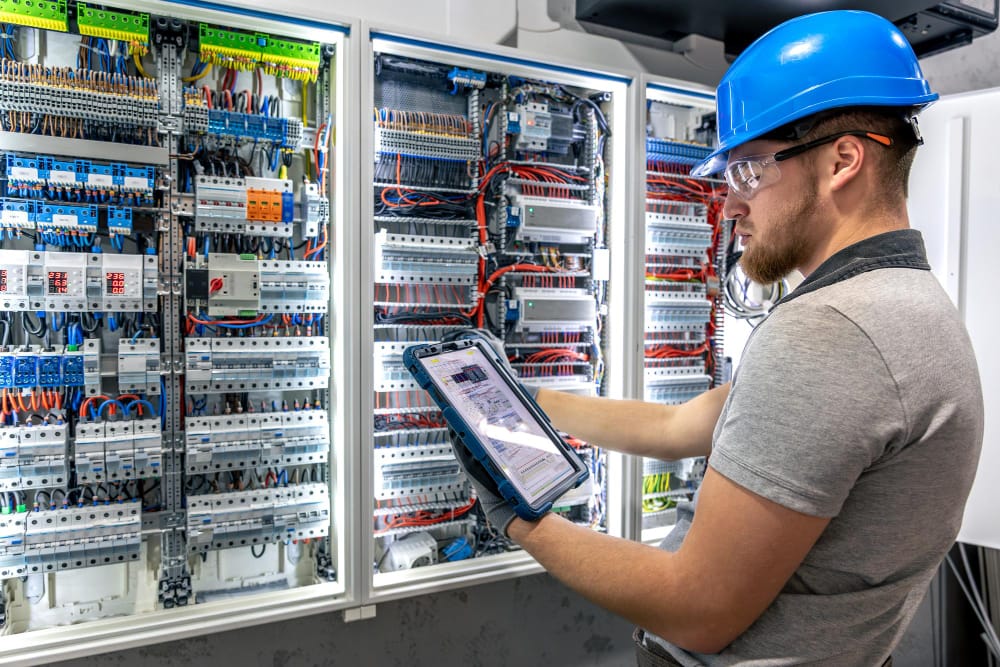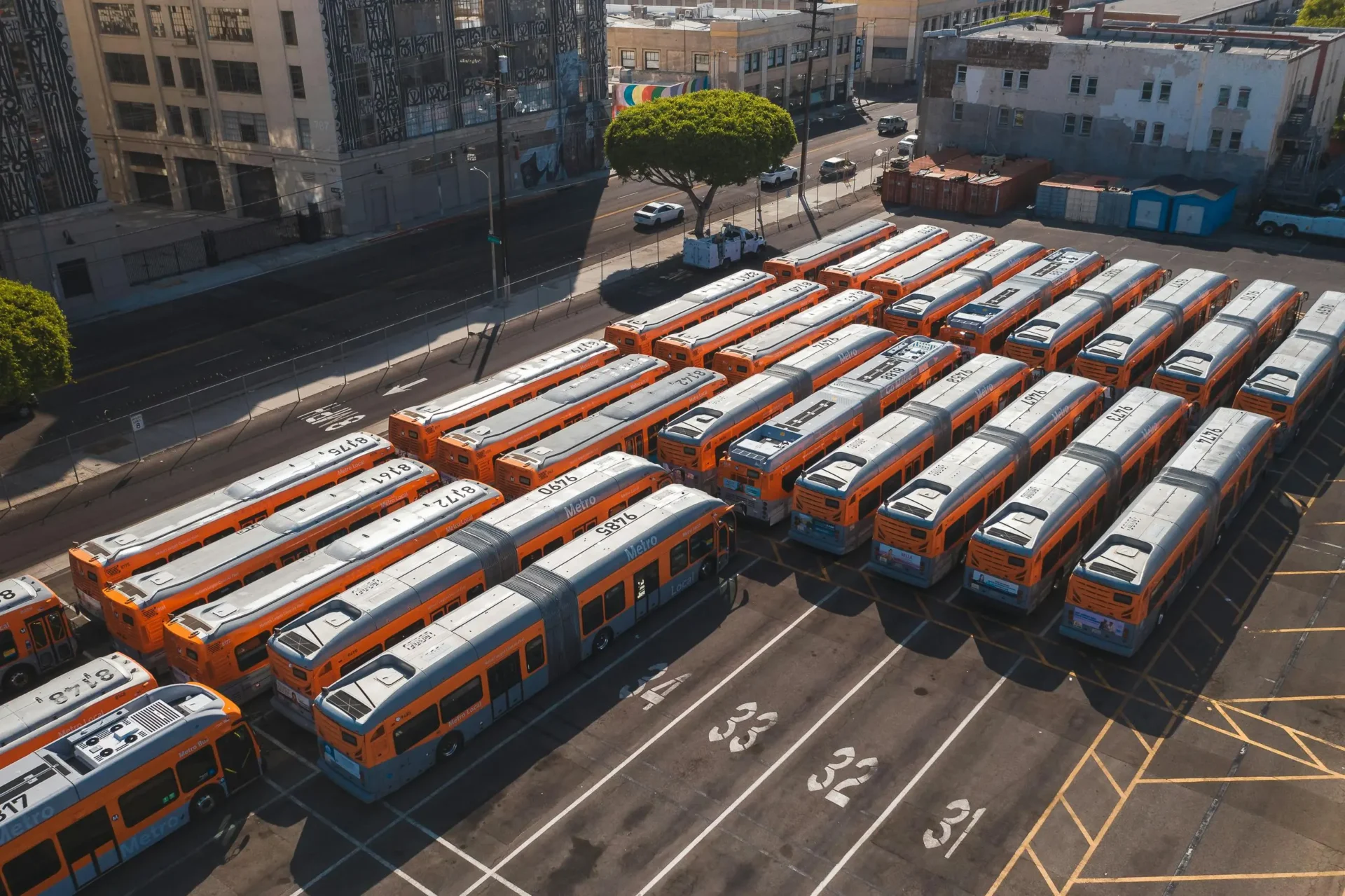Implementation of OpenADR for energy management shows savings of up to 8% in total electricity bills as well as 20% load reduction for large businesses. On one side, demand response automation is becoming a new industry standard. On the other side, the incentive can offer huge business advantages for businesses, from infrastructure providers and utility companies to manufacturers.
In this post, you’ll explore the concept and technicalities of OpenADR for energy management. Besides, you’ll find out how the technology works in detail, how it’s used for energy management, and what you should consider before getting started with OpenADR.
What is OpenADR
Above everything, you need an in-depth insight into what OpenADR is and how exactly it works in business:
Open Automated Demand Response (OpenADR) is an open, standardized communication protocol used to automatically exchange signals for adjusting electricity consumption.
In other words, OpenADR is a communication standard like a common language for sending and receiving demand response signals.
Origins & evolution of OpenADR
OpenADR originated in California in the early 2000s, when the state faced recurring energy crises and blackouts. To address the challenge, the California Energy Commission sponsored research at Lawrence Berkeley National Laboratory, where the first specification of Open Automated Demand Response was created.
The idea was simple: instead of relying on phone calls, emails, or manual actions, utilities could send automated signals directly to customer systems, prompting them to reduce or shift load during peak periods. Today, OpenADR has moved far beyond its California roots.
You can see the timeline of OpenADR adoption in the infographics below:
Core principles of OpenADR
At its core, OpenADR follows several principles that regulate the way this technology operates. They are as follows:
- Automated demand response without manual actions.
- Communication of all systems through a standardized protocol.
- Protected data exchange with secure, encrypted messaging.
- Scaling from individual devices to entire energy networks.
- Support for flexible use cases like peak reduction, DER, and EVs.
Main purposes of using OpenADR
Deriving from the definition of OpenADR, the technology helps energy providers and grid operators to balance demand and supply by automating demand response events. But that’s just the tip of the iceberg. Here are the main reasons to utilize OpenADR:
- Peak load management: Automatically reduce or shift consumption during high-demand periods, helping utilities avoid costly grid reinforcement.
- Renewable integration: Align consumption with variable solar and wind generation, reducing curtailment and maximizing clean energy use.
- DER coordination: Connect storage, EVs, and flexible loads into aggregated resources that participate in demand response markets.
- Cost optimization: Enable customers to benefit from dynamic pricing and incentive programs by automating load adjustments.
- Grid resilience: Provide fast, reliable demand-side response during emergencies or contingencies, improving overall system stability.
- Global standardization: Offer a proven, internationally recognized protocol (IEC 62746) that ensures interoperability across vendors and regions.
In the end, OpenADR boils down to enabling energy businesses to exchange information so they can operate smart grids better.
How OpenADR works
In essence, OpenADR operates through a two-node architecture, where the Virtual Top Node (VTN) and the Virtual End Node (VEN) exchange automated signals between energy providers and customers.
OpenADR key components (VTN & VEN)
VTN is the central server run by a utility or aggregator that sends demand response signals and collects performance data.
Essentially, VTN is the “command center” in the OpenADR architecture.
At the same time:
VEN is the customer-side client that receives signals from the VTN, executes load adjustments, and reports results back.
Basically, every device or piece of equipment, such as an EV charger or an industrial machine, connected to the grid, or an example of VEN.
OpenADR communication process
The process usually begins when a grid operator or utility detects a need to balance supply and demand, for example, during peak load, renewable variability, or a grid contingency. This triggers the creation of a demand response event, which is packaged as an OpenADR signal.
A demand response event is a scheduled or real-time request from a utility or grid operator for customers to reduce or shift their electricity consumption.
The exact procedure of how OpenADR works is provided in the infographics below:
- Event creation. The operator defines an event (start, duration, priority) and signal type (level/price/shed/temporal).
- Notification delivery. VTN sends oadrDistributeEvent; VEN receives via poll or push and validates signatures.
- Opt decision. VEN evaluates constraints and responds per event: opt-in/opt-out, with acknowledgements.
- Strategy mapping. VEN translates signals into control actions (e.g., Level 2 → HVAC +1.5°C, EVSE rate limit, battery discharge).
- Ramp & execute. After any ramp period, devices adjust setpoints/loads automatically for the event window.
- Monitoring & reports. VEN sends acks/telemetry and periodic reports (oadrCreate/UpdateReport) showing kW curtailed or shifted.
- Modify/cancel handling. If VTN updates/cancels the event, VEN adapts immediately and confirms.
- Event end & recovery. VEN restores normal schedules while managing rebound effects.
A demand response event is conducted at frequencies defined by program rules or real-time grid needs. They may follow scheduled patterns (daily peak shaving, time-of-use windows) or be triggered dynamically by emergencies, market prices, or renewable fluctuations.
Learn additionally about IoT in renewable energy from another blog post by Intelliarts.
Now, let’s proceed with reviewing key OpenADR components, the communication process, and the intricacies of integrating the technology with existing systems.
Integration of OpenADR with existing systems
Let’s see how OpenADR operates in pairs with some of the traditional systems your business might have in place already:
#1 EMS and BMS
The OpenADR protocol allows existing energy and building management systems (BMS) to automate HVAC, lighting, and industrial load controls. This reduces peak demand charges and improves operational efficiency without the need to establish new infrastructure.
Explore power grid load balancing in another blog post of ours.
#2 IoT devices
Smart thermostats, sensors, and EV chargers can serve as demand response enabling devices. With OpenADR integration, businesses gain granular control over individual assets, enabling faster response and better load management.
#3 Distributed Energy Resources (DERs)
Assets such as rooftop solar, batteries, and EV fleets are coordinated through open automated demand response. Businesses can maximize self-consumption, monetize flexibility, and participate in demand response markets.
Interested in building your own electric truck charging infrastructure? Take a read of our respective blog post.
Why OpenADR matters for energy management
Here are some of the many business benefits of openADR for energy management, with supporting sources indicated.
#1 Grid stability & resilience
OpenADR 3.0 simplifies messaging and helps grid owners manage forecasted and real-time power demand adjustments, improving system reliability and avoiding peaks. First OpenADR 3.0 certified products announced in 2025, including E.ON’s SWITCH platform, have shown superior results.
#2 Cost savings
In a 2014 LBNL demonstration of Auto-DR using OpenADR at four large commercial buildings in New York, enabling automated responses to day-ahead hourly pricing led to bill savings of 1.1% to 8.0% of total summer electricity bills.
#3 Sustainability & ESG alignment
OpenADR adoption helps integrate DERs (solar, batteries, EVs), enabling cleaner generation and flexibility, contributing towards sustainability and emission reductions. The 2024 Annual Report of the OpenADR Alliance points to growth in managing distributed energy resources using the OpenADR standard.
#4 Interoperability & scalability
The Pearlstone case study (UK/Europe) demonstrates OpenADR being used across a multi-site portfolio of buildings, giving smaller and geographically dispersed facilities access to demand response markets using a cloud-based, low-cost platform. This shows how it scales and interoperates across vendors and regions.
#5 Compliance & future-proofing
OpenADR 3.0 certification has begun (e.g., first certified VTN and VEN in 2025), enabling organizations to meet evolving regulatory demands and integrate modern DR & DER programs. As such, there was an announcement of the first OpenADR 3.0 certified products by E.ON, EVoke Systems, and Universal Devices in March 2025.
Demand response has tremendous potential to help with long-term reliability needs as well as daily system balancing needs. — Debra Lew, Executive Director of the Energy Systems Integration Group
Challenges of using OpenADR & key considerations
Here are the main challenges and considerations that any business must know before getting started with an openADR for energy management.
#1 High upfront investment
Integration and setup can require significant capital, especially for large facilities. At the same time, the end ROI largely depends on efficient deployment and early performance gains, so substantially cutting costs is not recommended.
Solution: Start with pilot projects to validate benefits before scaling system-wide.
#2 Cybersecurity requirements
Protecting sensitive grid and facility data is critical to avoid breaches. Compromised Demand Response (DR) systems can undermine trust and grid reliability.
Solution: Developers like Intelliarts use end-to-end encryption, secure APIs, and routine vulnerability testing to address this difficulty.
#3 High technical expertise needed
Implementing OpenADR for an energy management system requires specialized knowledge of energy systems and IT. Without it, integration risks delays and inefficiencies.
Solution: Partner with certified system integrators experienced in OpenADR.
#4 Certification matters
Non-certified devices may not fully comply with OpenADR specifications, leading to communication failures, security gaps, or regulatory non-compliance.
Solution: Prioritize OpenADR-certified hardware and software during procurement.
#5 Difficult change management
Shifting to automated demand response requires internal process adjustments. Without stakeholder buy-in, adoption can stall or underperform.
Solution: Provide staff training and clear communication on operational benefits.
#6 Ongoing maintenance
Systems require continuous monitoring and updates to stay effective. Neglecting maintenance can erode savings and reduce reliability.
Solution: Plan for regular system audits and software updates.
Pro tip: Any OpenADR system in place is required to comply with standards, including IEC 62746 and OASIS Energy Interoperation (EI). Ensuring compliance on the dev stage presents a difficulty, unless experienced tech partners are involved. However, given the successful compliance, the criticality of the challenges mentioned above diminishes.
How to get started with OpenADR
Finally, here’s a short guide that the Intelliarts team prepared for companies that are looking to integrate OpenADR in their business:
#1 Assessing readiness
The first step is understanding your facility’s energy profile. This includes:
- Analyzing consumption patterns
- Identifying peak load drivers
- Evaluating existing DER assets such as solar, storage, or EV fleets
A readiness assessment clarifies where demand response opportunities can deliver the strongest ROI. This is also an obligatory preparation step before connecting with technology service vendors.
You can’t manage what you don’t measure — understanding your energy profile is the foundation of every successful demand response strategy. — Alexander Barinov, Managing Partner at Intelliarts
#2 Choosing the right vendor
This is a tricky part. Depending on your business and your objectives for the project, you may need an integration with EMS, BMS, and DER platforms, custom software, additional hardware, etc. Once your intentions for the demand response automation project are clear, start selecting an OpenADR development provider.
Remember, trusted vendors and technology partners reduce integration risks and help you qualify for incentive programs without costly rework.
Explore an openADR protocol implementation success story by Intelliarts.
#3 Integration roadmap
With the right technology partner, integration becomes a guided process rather than a challenge. Your partner connects the OpenADR protocol to EMS, BMS, and IoT platforms, configures control strategies, and runs test events. This structured roadmap ensures smooth adoption, minimal disruption, and measurable performance improvements from the start.
Learn more about smart grids in IoT in another of our blog posts.
#4 Training & change management
Adopting OpenADR changes how facilities interact with the grid. Here are the types of staff members that will likely need additional training:
- Facility managers
- Operators
- IT staff
The listed professional will require clear procedures for event notifications, opt-in/opt-out decisions, and system reporting. Training ensures events are executed smoothly, while change management avoids operational surprises, such as unexpected HVAC shifts during peak hours.
#5 Scaling & future expansion
Most companies begin with one site or system to validate performance. Once event responses and savings are proven, OpenADR can be extended to additional facilities, larger DER portfolios, or EV fleets. Scaling gradually helps standardize processes across regions while aligning with evolving certification and regulatory requirements, such as OpenADR Certification Program (2.0b / 3.0) and the IEC 62746 Standard.
Final take
In a nutshell, demand response in energy management enables businesses to cut energy costs, enhance grid stability, and integrate DERs using a standardized, certified protocol. Success requires assessing readiness, selecting the right vendor, and ensuring smooth integration with EMS, BMS, and IoT systems. With proper training, monitoring, and scaling, companies can turn energy flexibility into measurable savings, compliance, and resilience.
Implementing OpenADR for energy management requires technical knowledge and experience with the technology. Should you require assistance, from a consultation to a full-scale development, reach out to Intelliarts. With more than 25 years of experience, 54% of senior staff engineers, and over 80 large projects under our belt, we can address your business needs.
FAQ
How does OpenADR differ from traditional demand response?
Traditional demand response relies on manual or semi-automated adjustments. OpenADR standard automates communication between utilities and facilities. This ensures faster response, higher accuracy, and consistent compliance with grid operator requirements.
Can OpenADR integrate with existing EMS/BMS platforms?
Yes. OpenADR integration works with most EMS and BMS platforms via standardized APIs. It enables smooth data exchange, load control, and real-time optimization without replacing existing systems.
What kind of ROI can businesses expect from OpenADR adoption?
ROI depends on energy use, tariffs, and participation level. Typical OpenADR benefits include reduced demand charges, incentive payments, and avoided infrastructure upgrades, with payback often achieved in one to three years.



